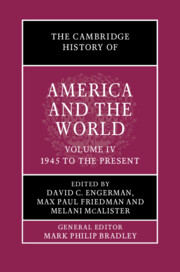Book contents
- The Cambridge History of America and the World
- The Cambridge History of America and the World
- The Cambridge History of America and the World
- Copyright page
- Contents
- Figures
- Maps
- Contributors to Volume IV
- General Introduction: What is America and the World?
- Introduction to Volume IV
- Part I Ordering a World of States
- Part II Challenging a World of States
- 10 US Foreign Policy and the End of Development
- 11 Oil and American Insecurity
- 12 US Mass Culture and Consumption in a Global Context
- 13 Imperial Visions of the World
- 14 Human Rights
- 15 Compassion and Humanitarianism in International Relations
- 16 Third World Internationalism and the Global Color Line
- 17 The Queering of US Geopolitics
- 18 Migration, War, and the Transformation of the US Population
- 19 Christian and Muslim Transnational Networks
- 20 Native Americans, Indigeneity, and US Foreign Policy
- 21 Environment, Climate, and Global Disorder
- 22 Détente and the Reconfiguration of Superpower Relations
- Part III New World Disorder?
- Index
19 - Christian and Muslim Transnational Networks
from Part II - Challenging a World of States
Published online by Cambridge University Press: 12 November 2021
- The Cambridge History of America and the World
- The Cambridge History of America and the World
- The Cambridge History of America and the World
- Copyright page
- Contents
- Figures
- Maps
- Contributors to Volume IV
- General Introduction: What is America and the World?
- Introduction to Volume IV
- Part I Ordering a World of States
- Part II Challenging a World of States
- 10 US Foreign Policy and the End of Development
- 11 Oil and American Insecurity
- 12 US Mass Culture and Consumption in a Global Context
- 13 Imperial Visions of the World
- 14 Human Rights
- 15 Compassion and Humanitarianism in International Relations
- 16 Third World Internationalism and the Global Color Line
- 17 The Queering of US Geopolitics
- 18 Migration, War, and the Transformation of the US Population
- 19 Christian and Muslim Transnational Networks
- 20 Native Americans, Indigeneity, and US Foreign Policy
- 21 Environment, Climate, and Global Disorder
- 22 Détente and the Reconfiguration of Superpower Relations
- Part III New World Disorder?
- Index
Summary
In March of 1945, two Indian men testified before the House Committee on Immigration and Naturalization of the US Congress. J. J. Singh, a tall, clean-shaven Sikh man in his late forties, sporting a closely-cropped haircut and a fine suit, stood in contrast to Mubarek Ali Khan, who was older, bespectacled, plainly dressed, and most conspicuously, wore a cap as a sign of Muslim faith. Just as their appearances differed starkly, so too did the logics of their respective arguments against the racial exclusion of Indian migrants from citizenship. Khan sought naturalization for the roughly 3,000 Indians (primarily farm, factory, railroad, and lumber-mill workers, though he was careful not to mention this) who settled in the United States prior to the Supreme Court decision of 1923, arguing that after two decades of work they deserved rights as Americans. Singh’s more ambitious bill sought to make future Indian immigrants racially eligible as citizens through an annual quota allowing 100 Indians to naturalize.
- Type
- Chapter
- Information
- The Cambridge History of America and the World , pp. 440 - 464Publisher: Cambridge University PressPrint publication year: 2022



